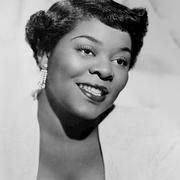Dinah Washington
Dinah Washingtong被乐迷们尊称为“蓝调之后”,多元而卓越的音乐性,使她能蓝调、爵士与流行等不同的曲风完美的结合在一起,而且表达的率直而自然,就象她的本质一样。从福音歌曲中启蒙,又从蓝调音乐中得到成长,最后以爵士音乐在乐坛享有至尊荣誉,即使无数的畅销专辑已足以肯定她在音乐上的崇高地位,但她始终忠于自己最真的音乐本质。Dinah Washingtongg本名RUTH LEE JONES,1924年8月24日生于阿拉巴马州的杜斯拉拉路沙。小时候移往芝加哥定局,15岁在芝加哥帝王剧院所举办的业余歌唱比赛中得奖之后,便开始在夜间俱乐部中演唱。1942年她的歌声被着名经纪人JOE CLASER发掘,安排她以Dinah Washingtong这个艺名与LIONEL HAMPTON大乐团一起演出,与乐团合作期间,她灌录了个人首张专辑,首张成名曲“EVIL GAL BLUES”便收录其中。1946年她离开乐团,开展个人的独唱事业,并以“I WANT TO BE LOVED”以及其它多首在当时被认为荒诞不经的蓝调歌曲建立个人在节奏蓝调的巨星地位。而她强烈直接的情感诉求与驾御式的舞台表现,使她的歌声不论是透过现场或录音,都同样给人强烈的印象。她说:“我喜欢找出每一个音符内在的含义,使每一个听众都能通过我的歌声听出点什幺来,更何况没有什幺歌是我不能唱的,什幺都难不倒我。”1946年,她与MERCURY唱片公司签下专属合同,开创了个人演唱事业的高峰,也为MERCURY公司留下无数的经典佳作。她的代表作有“JAIL HOUSE BLUES”、“POSTMAN BLUES”;1949年的“BABY GET LOST”;“I DO NOT HURT ANYMORE”;1955年的“WILLOW WEEP FOR ME”;1956年的“I'LL CLOSE MY EYES”;1959年的“WHAT A DIFFERENCE A DAY MAKES”这首曲子更疯狂的征服无数白人听众的心,专辑唱片并获得了当年50大唱片之一。Dinah Washingtong以独特的天赋拓展个人对不同音乐领域的表现,并与多位爵士大师象MAX ROACH、EDDIE DAVIS、CLIFFORD BROWN等人合作演出,由于她不可言喻的强烈音乐性,清晰的唱腔咬字以及完美的乐句表达,使她成为当代女爵士歌手中最具原创性与前瞻性的艺人之一。Dinah Washingtong的艺术成就不但在当代具有开创性的地位,并深深影响了后进无数女性歌手,象NANCY WILSON、ETTA JONES、ESTHER PHILLIPS等人都深受她个人风格所影响。即使在她死后近30年,她的唱片仍旧不断透过电台的播放而传送不断。by Richard S. GinellDinah Washington was at once one of the most beloved and controversial singers of the mid-20th century — beloved to her fans, devotees, and fellow singers; controversial to critics who still accuse her of selling out her art to commerce and bad taste. Her principal sin, apparently, was to cultivate a distinctive vocal style that was at home in all kinds of music, be it R&B, blues, jazz, middle of the road pop — and she probably would have made a fine gospel or country singer had she the time. Hers was a gritty, salty, high-pitched voice, marked by absolute clarity of diction and clipped, bluesy phrasing. Washingtons personal life was turbulent, with seven marriages behind her, and her interpretations showed it, for she displayed a tough, totally unsentimental, yet still gripping hold on the universal subject of lost love. She has had a huge influence on R&B and jazz singers who have followed in her wake, notably Nancy Wilson, Esther Phillips, and Diane Schuur, and her music is abundantly available nowadays via the huge seven-volume series The Complete Dinah Washington on Mercury.Born Ruth Lee Jones, she moved to Chicago at age three and was raised in a world of gospel, playing the piano and directing her church choir. At 15, after winning an amateur contest at the Regal Theatre, she began performing in nightclubs as a pianist and singer, opening at the Garrick Bar in 1942. Talent manager Joe Glaser heard her there and recommended her to Lionel Hampton, who asked her to join his band. Hampton says that it was he who gave Ruth Jones the name Dinah Washington, although other sources claim it was Glaser or the manager of the Garrick Bar. In any case, she stayed with Hampton from 1943 to 1946 and made her recording debut for Keynote at the end of 1943 in a blues session organized by Leonard Feather with a sextet drawn from the Hampton band. With Feathers Evil Gal Blues as her first hit, the records took off, and by the time she left Hampton to go solo, Washington was already an R&B headliner. Signing with the young Mercury label, Washington produced an enviable string of Top Ten hits on the R&B charts from 1948 to 1955, singing blues, standards, novelties, pop covers, even Hank Williams Cold, Cold Heart. She also recorded many straight jazz sessions with big bands and small combos, most memorably with Clifford Brown on Dinah Jams but also with Cannonball Adderley, Clark Terry, Ben Webster, Wynton Kelly, and the young Joe Zawinul (who was her regular accompanist for a couple of years). In 1959, Washington made a sudden breakthrough into the mainstream pop market with What a Diffrence a Day Makes, a revival of a Dorsey Brothers hit set to a Latin American bolero tune. For the rest of her career, she would concentrate on singing ballads backed by lush orchestrations for Mercury and Roulette, a formula similar to that of another R&B-based singer at that time, Ray Charles, and one that drew plenty of fire from critics even though her basic vocal approach had not changed one iota. Although her later records could be as banal as any easy listening dross of the period, there are gems to be found, like Billie Holidays Dont Explain, which has a beautiful, bluesy Ernie Wilkins chart conducted by Quincy Jones. Struggling with a weight problem, Washington died of an accidental overdose of diet pills mixed with alcohol at the tragically early age of 39, still in peak voice, still singing the blues in an L.A. club only two weeks before the end.


 Homeward Bound - Dinah Washington
Homeward Bound - Dinah Washington
























